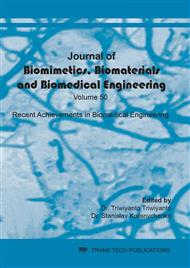[1]
R. Sudarno and S. D. Utomo, Disability Data Collection,, 2018, p.125.
Google Scholar
[2]
G. Pires and U. Nunes, A wheelchair steered through voice commands and assisted by a reactive fuzzy-logic controller,, J. Intell. Robot. Syst. Theory Appl., vol. 34, no. 3, p.301–314, 2002,.
Google Scholar
[3]
M. F. Ruzaij, S. Neubert, N. Stoll, and K. Thurow, Multi-sensor robotic-wheelchair controller for handicap and quadriplegia patients using embedded technologies,, in Proceedings - 2016 9th International Conference on Human System Interactions, HSI 2016, 2016, p.103–109,.
DOI: 10.1109/hsi.2016.7529616
Google Scholar
[4]
M. F. R. Al-Okby, S. Neubert, N. Stoll, and K. Thurow, Complementary functions for intelligent wheelchair head tilts controller,, SISY 2017 - IEEE 15th Int. Symp. Intell. Syst. Informatics, Proc., p.117–122, 2017,.
DOI: 10.1109/sisy.2017.8080536
Google Scholar
[5]
F. A. Cheein and R. Carelli, Autonomous Assistance Navigation for Robotic Wheelchairs in Confined Spaces,, IEEE EMBS, p.503–506, (2010).
DOI: 10.1109/iembs.2010.5625976
Google Scholar
[6]
R. A. Kalantri and D. K. Chitre, Automatic Wheelchair using Gesture Recognition,, IJEAT, no. 6, p.146–150, (2013).
Google Scholar
[7]
A. Tayab Noman, M. S. Khan, M. Emdadul Islam, and H. Rashid, A New Design Approach for Gesture Controlled Smart Wheelchair Utilizing Microcontroller,, 2018 Int. Conf. Innov. Sci. Eng. Technol., no. October, p.64–68, 2019,.
DOI: 10.1109/iciset.2018.8745607
Google Scholar
[8]
Z. Raiyan, M. S. Nawaz, A. K. M. A. Adnan, and M. H. Imam, Design of an arduino based voice-controlled automated wheelchair,, 5th IEEE Reg. 10 Humanit. Technol. Conf. 2017, R10-HTC 2017, vol. 2018-Janua, p.267–270, 2018,.
DOI: 10.1109/r10-htc.2017.8288954
Google Scholar
[9]
J. Kilby, K. Prasad, and G. Mawston, Multi-channel surface electromyography electrodes: A review,, IEEE Sens. J., vol. 16, no. 14, p.5510–5519, 2016,.
DOI: 10.1109/jsen.2016.2569072
Google Scholar
[10]
L. Sathishbalaji and R. Bhakkyalakshmi, Electric Wheelchair Controlled by EMG Signals with Obstacle Detection,, J. Innov. Res. Solut., vol. 2, no. 2, p.1409–1412, (2014).
Google Scholar
[11]
Bakhtiyar Arasada and B. Suprianto, Application of Ultrasonic Sensors for Detection of Distance Position in Spaces Using Arduino Uno Application of Ultrasonic Sensors for Detection of Position Positions in Spaces Using Arduino Uno,, Electr. Eng., p.1–8, (2017).
Google Scholar
[12]
M. Andayani, W. Indrasari, and B. H. Iswanto, Calibration of HCSR-04 Ultrasonic Sensor as a Distance Detection Sensor in Prototype of Flood Disaster Early Warning System,, Pros. Natl. Phys. Semin. (E-JOURNAL), 5, SNF2016-CIP., vol. V, p.43–46, (2016).
Google Scholar
[13]
I. P. T. Indrayana, T. Julian, and K. Triyana, Testing Data Acquisition of Ultrasonic Sensor HC-SR04 using Atmega 8535 Microcontroller,, UNIERA, vol. 8535, p.35–40.
Google Scholar
[14]
G. Liu, M. Yao, and L. Zhang, Fuzzy Controller for Obstacle Avoidance In Electric Wheelchair With Ultrasonic Sensors,, IEEE Int. Symp. Innov. Intell. Syst. Appl. Proc., 2011,.
DOI: 10.1109/isccs.2011.27
Google Scholar
[15]
H. Murakami and H. Seki, Fuzzy Algorithm Based Obstacle Avoidance Control of Electric Powered Wheelchair using Ultrasonic Sensor,, Annu. Conf. IEEE Ind. Electron., p.4251–4256, (2009).
DOI: 10.1109/iecon.2009.5415071
Google Scholar
[16]
D. A. Sanders, J. Graham-Jones, and A. Gegov, Improving ability of tele-operators to complete progressively more difficult mobile robot paths using simple expert systems and ultrasonic sensors,, Ind. Rob., vol. 37, no. 5, p.431–440, 2010,.
DOI: 10.1108/01439911011063254
Google Scholar
[17]
M. E. Saputra Aji, Dwi , Bana Handaga, Simulation of Speed Control Programming System in Remote Control Car Design Using PWM Based on HCSR-04 Ultrasonic Sensor and Arduino Microcontroller,, Electron. Theses Disertations Univ. Muhammadiyah Surakarta, (2017).
Google Scholar
[18]
S. Arifin and A. Fathoni, Utilization of Pulse Width Modulation to Control Motors (Case Study of Automatic Robot Two Deviana),, J. Ilm. Teknol. Inf. Asia, vol. 8, no. 2, p.65–80, (2014).
Google Scholar
[19]
Gangahyeon, Electric wheelchair with resting place sharing system and rear sensor using sensor and wireless communication,, Pat. Publ., vol. 1740987, no. 19, p.1–14, (2017).
Google Scholar
[20]
Dryvendra, M. Ramalingam, E. Chinnavan, R. Puviarasi, and Raguraman, A better engineering design: Low cost assistance kit for manual wheelchair users with enhanced obstacle detection,, J. Eng. Technol. Sci., vol. 47, no. 4, p.389–405, 2015,.
DOI: 10.5614/j.eng.technol.sci.2015.47.4.4
Google Scholar
[21]
K. K. Kim, Smart electric wheelchair,, Pat. Publ. 10-2019-0059489, vol. 1740987, no. 19, p.1–14, (2019).
Google Scholar
[22]
M. Masmoudi, I. Klabi, and M. S. Masmoudi, Advanced user interfaces for intelligent wheelchair system,, 2014 1st Int. Conf. Adv. Technol. Signal Image Process. ATSIP 2014, p.130–136, 2014,.
DOI: 10.1109/atsip.2014.6834592
Google Scholar
[23]
D. A. Sanders, Using Self-Reliance Factors to Decide How to Share Control between Human Powered Wheelchair Drivers and Ultrasonic Sensors,, IEEE Trans. Neural Syst. Rehabil. Eng., vol. 25, no. 8, p.1221–1229, 2017,.
DOI: 10.1109/tnsre.2016.2620988
Google Scholar
[24]
T. Debnath, A. Z. Abadin, and M. A. Hossain, PWM Based Android Controlled Wheel Chair,, Int. J. Comput. Sci. Inf. Technol., vol. 10, no. 2, p.57–64, 2018,.
DOI: 10.5121/ijcsit.2018.10205
Google Scholar
[25]
Cytron Technologies, HC-SR04 Ultrasonic Sensor,, HC-SR04 Datasheet, p.1–10, (2013).
Google Scholar
[26]
A. Bingham, X. Hadoux, and D. K. Kumar, Implementation of a safety system using ir and ultrasonic devices for mobility scooter obstacle collision avoidance,, ISSNIP Biosignals Biorobotics Conf. BRC, 2014,.
DOI: 10.1109/brc.2014.6881000
Google Scholar


